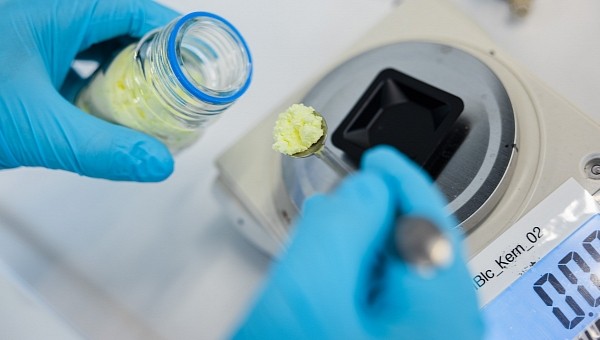Lithium-sulfur batteries are considered a better alternative to Li-ion, thanks to advantages like a lower price, raw-material abundance, and being more energy dense. Nevertheless, lithium-sulfur batteries have their own drawbacks, which prevent them from becoming widespread. Scientists claim they have found a solution, paving the way for commercial lithium-sulfur cell production.
Almost everything, from cell phones to smartwatches to electric vehicles, is powered today by a Li-ion battery. The ubiquity of the technology has become their biggest asset, despite problems such as the short lifespan, overheating, and supply-chain challenges for certain raw materials. Nevertheless, researchers are busy developing new types of battery cells that promise to hold more energy for longer without the problems experienced by the current Li-ion cells.
One of the most promising technologies is lithium-sulfur chemistry. Using sulfur in battery cells promises to increase the energy density beyond current Li-ion batteries. Besides that, sulfur is cheap and easy to source, thus having the potential to bring down the cost of manufacturing electric vehicles. Lithium-sulfur batteries usually pair a sulfur-containing positive electrode (cathode) with a lithium metal negative electrode (anode). The electrolyte allows the ions to pass between the two electrodes during charging and discharging.
For all its advantages, sulfur has a nasty problem because the sulfur species (polysulfides) dissolve into the electrolyte, causing its corrosion. This is called the polysulfide shuttling effect and is responsible for a drastic reduction in the number of times the battery can be recharged. It makes Li-S batteries dead in the water, although scientists also work hard to mitigate this problem.
One method to prevent the shuttling effect is placing a redox-inactive interlayer between the cathode and anode. “Redox-inactive” means that the material does not undergo reactions like the electrodes. The solution does prevent the shuttling effect to some extent, but it adds another problem: because it is dense and heavy, this layer reduces the battery’s energy density. This is a major problem that prevents the commercialization of Li-S cells.
Now, researchers at the U.S. Department of Energy’s (DOE) Argonne National Laboratory have found a porous material that can work miracles in reducing the shuttling effect without the drawbacks of the redox-inactive layer. Laboratory tests showed that the initial energy capacity is three times higher with this active interlayer than with the redox-inactive layer. Even more impressively, the active-interlayer cells maintained a high energy capacity over 700 charge-discharge cycles.
“Previous experiments with cells having the redox-inactive layer only suppressed the shuttling, but in doing so, they sacrificed the energy for a given cell weight because the layer added extra weight,” said Guiliang Xu, an Argonne chemist and co-author of the research. “By contrast, our redox-active layer adds to energy storage capacity and suppresses the shuttle effect.”
Scientists are working to find out if they can still make the active interlayer thinner and lighter, thus improving the energy density without sacrificing the benefits. The research points to lithium-sulfur batteries getting one step closer to making a lasting impact on our lives.
One of the most promising technologies is lithium-sulfur chemistry. Using sulfur in battery cells promises to increase the energy density beyond current Li-ion batteries. Besides that, sulfur is cheap and easy to source, thus having the potential to bring down the cost of manufacturing electric vehicles. Lithium-sulfur batteries usually pair a sulfur-containing positive electrode (cathode) with a lithium metal negative electrode (anode). The electrolyte allows the ions to pass between the two electrodes during charging and discharging.
For all its advantages, sulfur has a nasty problem because the sulfur species (polysulfides) dissolve into the electrolyte, causing its corrosion. This is called the polysulfide shuttling effect and is responsible for a drastic reduction in the number of times the battery can be recharged. It makes Li-S batteries dead in the water, although scientists also work hard to mitigate this problem.
One method to prevent the shuttling effect is placing a redox-inactive interlayer between the cathode and anode. “Redox-inactive” means that the material does not undergo reactions like the electrodes. The solution does prevent the shuttling effect to some extent, but it adds another problem: because it is dense and heavy, this layer reduces the battery’s energy density. This is a major problem that prevents the commercialization of Li-S cells.
Now, researchers at the U.S. Department of Energy’s (DOE) Argonne National Laboratory have found a porous material that can work miracles in reducing the shuttling effect without the drawbacks of the redox-inactive layer. Laboratory tests showed that the initial energy capacity is three times higher with this active interlayer than with the redox-inactive layer. Even more impressively, the active-interlayer cells maintained a high energy capacity over 700 charge-discharge cycles.
“Previous experiments with cells having the redox-inactive layer only suppressed the shuttling, but in doing so, they sacrificed the energy for a given cell weight because the layer added extra weight,” said Guiliang Xu, an Argonne chemist and co-author of the research. “By contrast, our redox-active layer adds to energy storage capacity and suppresses the shuttle effect.”
Scientists are working to find out if they can still make the active interlayer thinner and lighter, thus improving the energy density without sacrificing the benefits. The research points to lithium-sulfur batteries getting one step closer to making a lasting impact on our lives.






